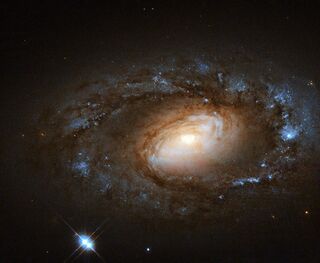Astronomy:NGC 4102
Coordinates: ![]() 12h 06m 23.115s, +52° 42′ 39.42″
12h 06m 23.115s, +52° 42′ 39.42″
| NGC 4102 | |
|---|---|
 NGC 4102 image taken by the Hubble Space Telescope | |
| Observation data (J2000 epoch) | |
| Constellation | Ursa Major[1] |
| Right ascension | 12h 06m 23.115s[2] |
| Declination | +52° 42′ 39.42″[2] |
| Redshift | 0.002792[3] |
| Helio radial velocity | 837 km/s[4] |
| Distance | 59.6 Mly (18.3 Mpc)[5] |
| Group or cluster | Ursa Major group[6] |
| Apparent magnitude (V) | 11.2[7] |
| Apparent magnitude (B) | 11.8[8] |
| Characteristics | |
| Type | SAB(s)b,[9][10] SABab[3] |
| Apparent size (V) | 2.9′ × 1.8′[7] |
| Notable features | LINER[9] |
| Other designations | |
| IRAS 12038+5259, WISE J120623.07+524239.8, UGC 7096, MCGMCG+09-20-094, PGC 38392[8] | |
NGC 4102 is an intermediate[9] barred spiral galaxy located in the northern constellation of Ursa Major. It is visible in a small telescope and has an apparent visual magnitude of 11.2.[7] The galaxy was discovered April 12, 1789 by William Herschel. J. L. E. Dreyer described it as "bright, pretty small, round, brighter middle and bright nucleus".[11] This galaxy is located at a distance of 60[5] million light years and is receding with a heliocentric radial velocity of 837 km/s.[4] It is a member of the Ursa Major group of galaxies.[6]
The morphological class of NGC 4102 is SABab[3] or SAB(s)b?,[10] which is a spiral galaxy with a bar-like feature around the core (SAB), no inner ring structure (s), and moderately tightly-wound spiral arms ('ab' or 'b'). However, the bar in this galaxy is considered particularly small for galaxies of this class.[10] The galactic plane is inclined at an angle of 56°±2° to the line of sight from the Earth.[12] NGC 4102 has a region of intense star formation in the nuclear region, known as a starburst region.[6] This volume is 1,000 ly (310 pc) in diameter containing some 3 billion solar masses.[13] An outflow of hydrogen has been detected, extending outward to the northwest as far as 6.3 kpc (21 kly) from the nucleus.[14]
The core of NHC 4102 is almost certainly an active galactic nucleus (AGN),[15] which indicates it has a supermassive black hole (SMBH) that is generating energy by accreting material.[16] It is an X-ray source with a spectrum similar to a Seyfert 2 galaxy.[15] This type of AGN is known as a Type-2 LINER, or low-ionization nuclear emission-line region. This is due to a core that is obscured by intervening dusty materials and/or the SMBH is accreting material in an inefficient manner. The bolometric luminosity of the active nucleus is ~7×1043 erg·s−1.[16]
One supernova has been observed in NGC 4102: SN 1975E (type unknown, mag. 16.7).[17]
References
- ↑ Jump up to: 1.0 1.1 "This is no supermodel spiral". ESA/Hubble. http://www.spacetelescope.org/images/potw1448a/.
- ↑ Jump up to: 2.0 2.1 2.2 Skrutskie, Michael F. et al. (1 February 2006). "The Two Micron All Sky Survey (2MASS)". The Astronomical Journal 131 (2): 1163–1183. doi:10.1086/498708. ISSN 0004-6256. Bibcode: 2006AJ....131.1163S.
- ↑ Jump up to: 3.0 3.1 3.2 3.3 Ann, H. B. et al. (2015). "A Catalog of Visually Classified Galaxies in the Local (z ∼ 0.01) Universe". The Astrophysical Journal Supplement Series 217 (2): 27. doi:10.1088/0067-0049/217/2/27. Bibcode: 2015ApJS..217...27A.
- ↑ Jump up to: 4.0 4.1 4.2 Tully, R. Brent et al. (2016). "Cosmicflows-3". The Astronomical Journal 152 (2): 21. doi:10.3847/0004-6256/152/2/50. 50. Bibcode: 2016AJ....152...50T.
- ↑ Jump up to: 5.0 5.1 5.2 Lianou, S. et al. (November 2019). "Dust properties and star formation of approximately a thousand local galaxies". Astronomy & Astrophysics 631: 19. doi:10.1051/0004-6361/201834553. A38. Bibcode: 2019A&A...631A..38L.
- ↑ Jump up to: 6.0 6.1 6.2 6.3 Beck, Sara C. et al. (October 2010). "NGC 4102: High-resolution Infrared Observations of a Nuclear Starburst Ring". The Astrophysical Journal 722 (2): 1175–1179. doi:10.1088/0004-637X/722/2/1175. Bibcode: 2010ApJ...722.1175B.
- ↑ Jump up to: 7.0 7.1 7.2 7.3 O'Meara, Steve (2007). Herschel 400 Observing Guide. Cambridge University Press. p. 98. ISBN 9780521858939. https://books.google.com/books?id=Nyh9fAC_tpIC&pg=PA98.
- ↑ Jump up to: 8.0 8.1 8.2 "NGC 4102". SIMBAD. Centre de données astronomiques de Strasbourg. http://simbad.u-strasbg.fr/simbad/sim-basic?Ident=NGC+4102.
- ↑ Jump up to: 9.0 9.1 9.2 9.3 "NED results for object NGC 4102". NASA/IPAC Extragalactic Database. http://ned.ipac.caltech.edu/cgi-bin/objsearch?objname=ngc+4102&extend=no&hconst=73&omegam=0.27&omegav=0.73&corr_z=1&out_csys=Equatorial&out_equinox=J2000.0&obj_sort=RA+or+Longitude&of=pre_text&zv_breaker=30000.0&list_limit=5&img_stamp=YES.
- ↑ Jump up to: 10.0 10.1 10.2 10.3 Erwin, Peter; Debattista, Victor P. (June 2013). "Peanuts at an angle: detecting and measuring the three-dimensional structure of bars in moderately inclined galaxies". Monthly Notices of the Royal Astronomical Society 431 (4): 3060–3086. doi:10.1093/mnras/stt385. Bibcode: 2013MNRAS.431.3060E.
- ↑ Jump up to: 11.0 11.1 Seligman, Courtney. "NGC 4102 (= PGC 38392)". Celestial Atlas. https://cseligman.com/text/atlas/ngc41.htm#4102.
- ↑ Jump up to: 12.0 12.1 Verheijen, Marc A. W. (December 2001). "The Ursa Major Cluster of Galaxies. V. H I Rotation Curve Shapes and the Tully-Fisher Relations". The Astrophysical Journal 563 (2): 694–715. doi:10.1086/323887. Bibcode: 2001ApJ...563..694V.
- ↑ Jump up to: 13.0 13.1 "Hubble Spies Charming Spiral Galaxy Bursting with Stars". SpaceDaily. 8 December 2014. http://www.spacedaily.com/reports/Hubble_Spies_Charming_Spiral_Galaxy_Bursting_with_Stars_999.html.
- ↑ Jump up to: 14.0 14.1 Trent Braun, Timothy; van Zee, Liese; Richards, Emily E.; McQuinn, Kristen B.; Skillman, Evan D.; Edges (January 2015). "Detection of an Extended Outflow in NGC 4102". AAS Meeting #225 (American Astronomical Society) 225. 250.27. Bibcode: 2015AAS...22525027T.
- ↑ Jump up to: 15.0 15.1 15.2 Mathur, Smita; Ghosh, Himel; Ferrarese, Laura; Fiore, Fabrizio (October 2008). "Finding Local Low-mass Supermassive Black Holes". Observational Evidence for Black Holes in the Universe: Proceedings of the 2nd Kolkata Conference on Observational Evidence for Black Holes in the Universe held in Kolkata India, 10-15 February 2008 and the Satellite Meeting on Black Holes, Neutron Stars, and Gamma-Ray Bursts held 16-17 February 2008. 1053. pp. 43–49. doi:10.1063/1.3009521. Bibcode: 2008AIPC.1053...43M.
- ↑ Jump up to: 16.0 16.1 16.2 González-Martín, O. et al. (March 2011). "Suzaku observation of the LINER NGC 4102". Astronomy & Astrophysics 527: 10. doi:10.1051/0004-6361/201016097. A142. Bibcode: 2011A&A...527A.142G.
- ↑ Transient Name Server entry for SN 1975E. Retrieved 29 March 2023.
External links
 |

